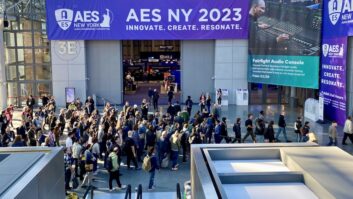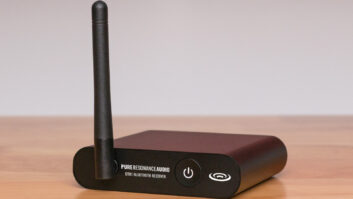Raleigh, NC––RMB Audio has provided audio for the J.S. Dorton Arena at the North Carolina State Fair for 21 years, and even though they’ve used Martin Audio throughout that time, this year marked their first deployment of the MLA Compact system.
Dorton Arena is the venue for evening performance concerts held during the State Fair with performers such as Michael W. Smith, Brian McKnight, local hero and American Idol Winner Scotty McCreery and other artists over 11 nights.
A historic 7,610-seat arena built in 1952 that features an unusual parabolic shape with an elliptical outer wall; Dorton was listed in the national register of historic places in 1974. Though unique in its design, the venerable hall presents significant audio challenges according to RMB Audio owner, Cooper Cannady.
“It’s a beautiful space, but the arena is very difficult for sound engineers,” Cannady explains. “It’s not a symmetrical room by any means and there’s a lot of concrete, glass and open space; it’s kind of like providing sound coverage over a Pringle surface. Plus it’s tough on the audience because in the elevated seating left and right of the stage, your seat faces the middle of the room so you have to turn from 30º to 60º to face the stage.”
Over the years, Cannady and RMB Audio have solved problems with carefully tuned Martin Audio loudspeaker systems. This year they decided to deploy the new MLA Compact and benefit from its software-driven approach to overcome any issues encountered with the arena.
The system consisted of 12 MLA Compact enclosures and six DSX218 ground-stacked subs per side, along with twelve W8LM boxes per side for outfill “which can generate 117 db alone without having it sound unpleasant,” adds Cannady.
Given the demand for MLA Compact, Cannady and his crew at RMB had to get an early start familiarizing themselves with the system: “Starting in May we’d been working up schedules to have the MLA Compact rig in that would match the timeline for the fair and also have the integrated training for MLA Compact. Somehow, we got all those things worked out. The third day of our training class, normally how you fly it, position it, design the room––all of that occurred on the day we would normally install the system.
“The training went well and we had Ferrit Rowe (Martin Audio MLA technical support specialist) who held over for the first performance night, which featured the local North Carolina University a Capella groups. And a Capella singing has taken on a whole new platform with soloists, background voice instruments, rhythm percussion voices and all things that fall into the category.
“The wonderful part was having Roger Dennis who’s been A1 audio for the Fair with us for 21 years, and that was the most I’ve seen him smile since I’ve known him. All of which had to do with the articulation from the MLA Compact loudspeakers that was so well defined with so little room reactivity.
“Because of the MLA Compact’s controllability via the software, we did a lot of design to avoid the room aberrations. At the back of room you have the PA, which has to clear a certain height to have no visual interruption for the seating, so we take a slice at that point and 180 feet in front of that is glass and two big 18 ft. load-in doors that are huge reflectors. In our programming, we designed it so the sound would stop 10 feet in front of the doors.
“We really enjoyed working with MLA Compact,” Cannady continues. “I liked the sophistication of it, especially the audience to speaker cabinet theory the designers Jason (Baird) and Ambrose (Thompson) had formulated this whole cabinet concept based on the close proximity between driver components and mathematically quantifying the box to box interference and/or enhancement that is corrected through algorithms that formulate sound direction to the start and stop positions. The speaker optimization software function has nothing to do with what the room’s reverb time or acoustic benefits and deficiencies. The software algorithms do all of the work to direct sound at the specified SPL that can be louder in the back than at the front if needed.”
“It all comes down to having good input dimensional data of the space to generate the design and then just input where the system will be located. Input where you want sound to start and stop and specifically where you do not want sound, specifically on stage, which is something I really love about it. You run the room design through the step-by-step operation of the system, allow the software to do its optimization, take a look at that and right out of the box you can mix off the console without doing a lot of outboard major EQ for the room.
“And they’ve done a fabulous job with the components in the speakers. When I first saw the specs, I had a lot of questions. But when I heard the rig I thought it sounded like any other Martin Audio rig that’s been fine-tuned, EQ’d and properly positioned. On first listen it sounded like a system where we’d spent three hours doing SMAART.”
Asked about reactions to the MLA Compact, Cooper concludes, “The touring engineers coming through were really impressed and in some cases, this was the first time they’d mixed with MLA Compact. The ones who didn’t have any preconceptions about the system and listened well before affecting their artistic EQ changes to the audio path did not make any changes after they heard it. Many of them wanted to hear MLA Compact in a much better sounding room. They were pleased enough to say, ‘I really want to hear this again.’”
Photos provided by Tobias Cannady
For more about Martin Audio, please click to www.martin-audio.com.







